Efficient requirement documentation for successful project execution and client satisfaction is crucial in software engineering. Software developers and project managers must understand the significance of requirement documentation in software engineering. It serves as a roadmap, outlining functional requirements, system features, and interface requirements for the development team. Delving into this concept enables developers to fix clarity, a challenge arising from precise software requirement specifications that require rigorous adjustments.
Aloa, an expert in software outsourcing, understands the critical role of requirement documentation in ensuring project success. Our experience shows how well-documented software requirements streamline the development process and enhance product quality. Our team leverages use cases, user stories, and technical specifications to create detailed software requirement documents, guiding the development team through various tasks and ensuring alignment with project objectives.
In this blog, you will gain valuable insights into the software requirement documentation process and understand how it benefits product quality and development efficiency. Afterward, you'll be guided through the Requirement Documentation in software engineering smartly and efficiently. Stay tuned for valuable tips and tricks that enhance your software development process and product development outcomes.
Let's dive in!
What Is Requirement Documentation in Software Engineering?
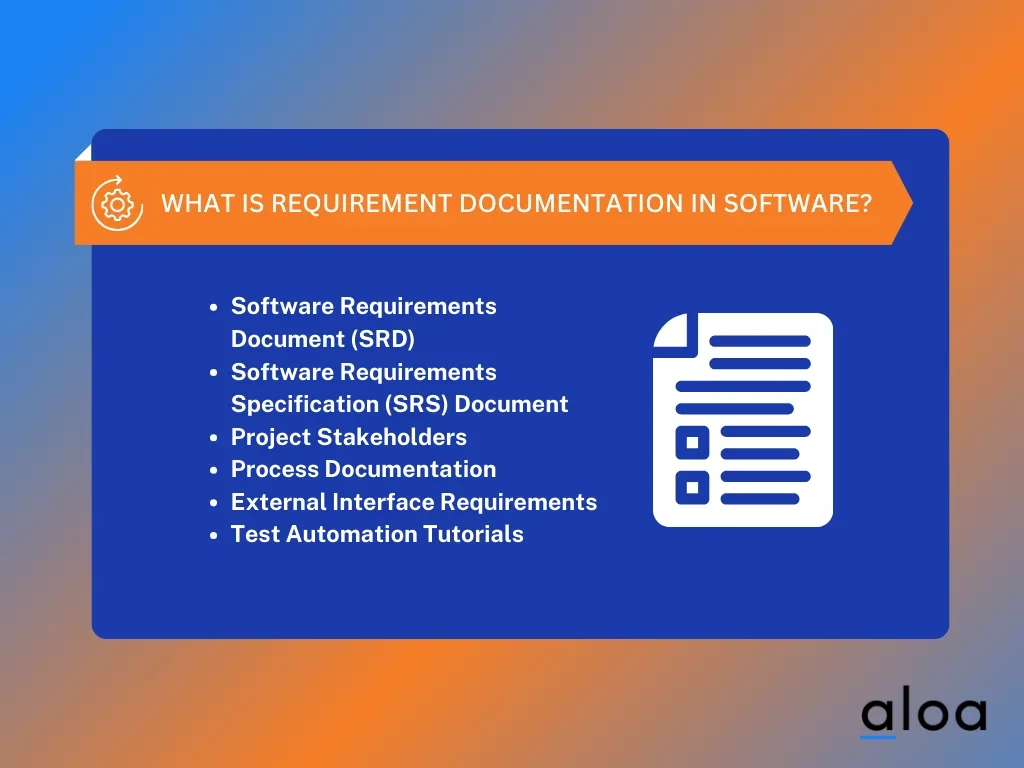
Requirement documentation in software engineering is the systematic process of documenting all necessary information related to a software project's requirements. It serves as a single source of truth for project stakeholders, including product managers, software testers, and developers. Investing in requirement documentation is a good practice for ensuring project success.
Key components include:
- Software Requirements Document (SRD): The foundation of requirement documentation, the SRD outlines functional requirements, non-functional requirements, and external components necessary for the software's functionality and performance.
- Software Requirements Specification (SRS) Document: An elaboration of the SRD, the SRS document provides a detailed breakdown of requirements, often including diagrams, code snippets, and acronyms for clarity and precision.
- Project Stakeholders: Vital contributors to requirement documentation, including product managers, developers, testers, and key stakeholders from client organizations.
- Process Documentation: Describes the methodology for eliciting, analyzing, and validating requirements, ensuring a smart, efficient approach to software development.
- External Interface Requirements: Specifies the interactions between the software system and external components, such as APIs, databases, or third-party services.
- Test Automation Tutorials: Guides automated testing techniques to ensure software quality and reliability.
Requirement documentation in software engineering is a good practice and tool for ensuring project success and delivering exceptional user experiences. Maintaining clear, comprehensive documentation, teams can confidently navigate complex software projects, meeting client expectations and industry standards.
How To Make Requirement Documentation in Software Engineering
A structured approach is essential for project success in requirement documentation in software engineering. Here are five steps to guide you through the process, ensuring clarity, accuracy, and alignment with project objectives and stakeholder needs.
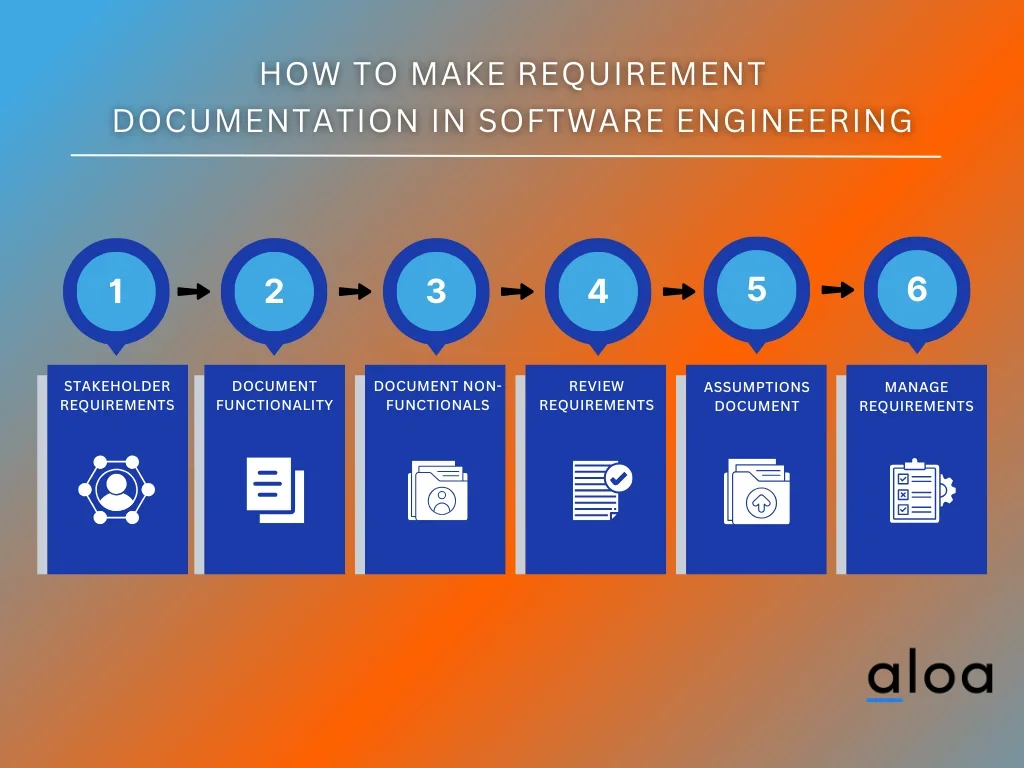
Step 1: Identify Stakeholders and Gather Requirements
In requirement documentation in software engineering, the first crucial step is to identify all stakeholders engaged in the project, including clients, end-users, developers, testers, and project managers. Recognizing these key players ensures comprehensive coverage of perspectives and needs.
Gathering requirements is essential and is achieved through various means such as interviews, surveys, workshops, or reviewing existing documentation. Active stakeholder engagement facilitates a thorough understanding of project objectives, constraints, and user expectations.
Key questions to ask during this phase include:
- Who are the primary stakeholders, and what are their roles?
- What methods will be employed to gather requirements effectively?
- How can existing documentation be leveraged or updated?
Thorough stakeholder identification and meticulous requirement gathering are pivotal in requirement documentation in software engineering. Projects are better positioned for success by actively involving all relevant parties and employing effective methods, ensuring alignment with objectives and user needs.
Step 2: Document Functional Requirements
In requirement documentation in software engineering, a crucial step is documenting functional requirements. This involves precisely defining what the software system should accomplish. Techniques such as use cases, user stories, or functional specifications articulate the system's behavior from the user's standpoint.
Here are the organized requirements in a structured format:
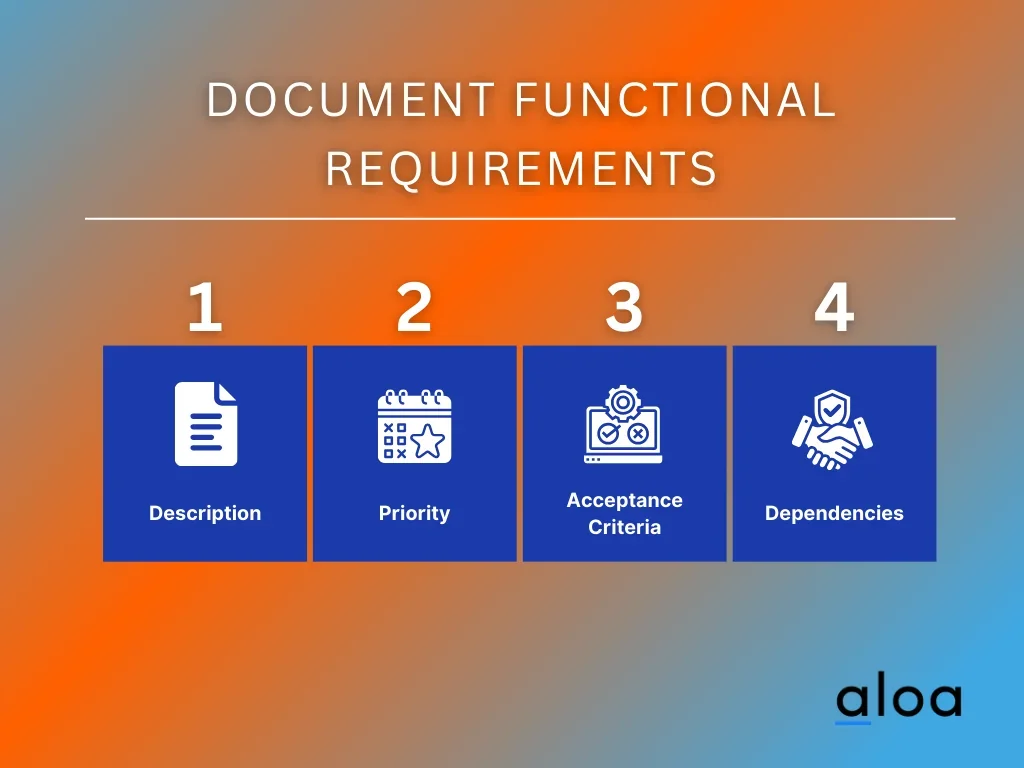
- Description: Clearly define what tasks or functions the software must perform.
- Priority: Assign priority levels to each requirement to guide development efforts.
- Acceptance Criteria: Establish criteria that must be met for each requirement to be considered complete.
- Dependencies: Identify any dependencies between requirements or with external factors.
Organizing functional requirements in a structured format, teams ensure clarity, alignment, and feasibility in the development process. This meticulous documentation is a product roadmap for developers and stakeholders, ensuring the final product meets the desired objectives.
Accurate and comprehensive documentation of functional requirements is essential in software engineering to guide development efforts effectively and ensure alignment with stakeholder expectations.
Step 3: Document Non-Functional Requirements
Non-functional requirements, including performance, scalability, security, and usability, shape the system's overall quality. In requirement documentation in software engineering, it's imperative to include these alongside functional requirements for a holistic understanding of system expectations.
Non-functional requirements define the system's quality attributes, such as:
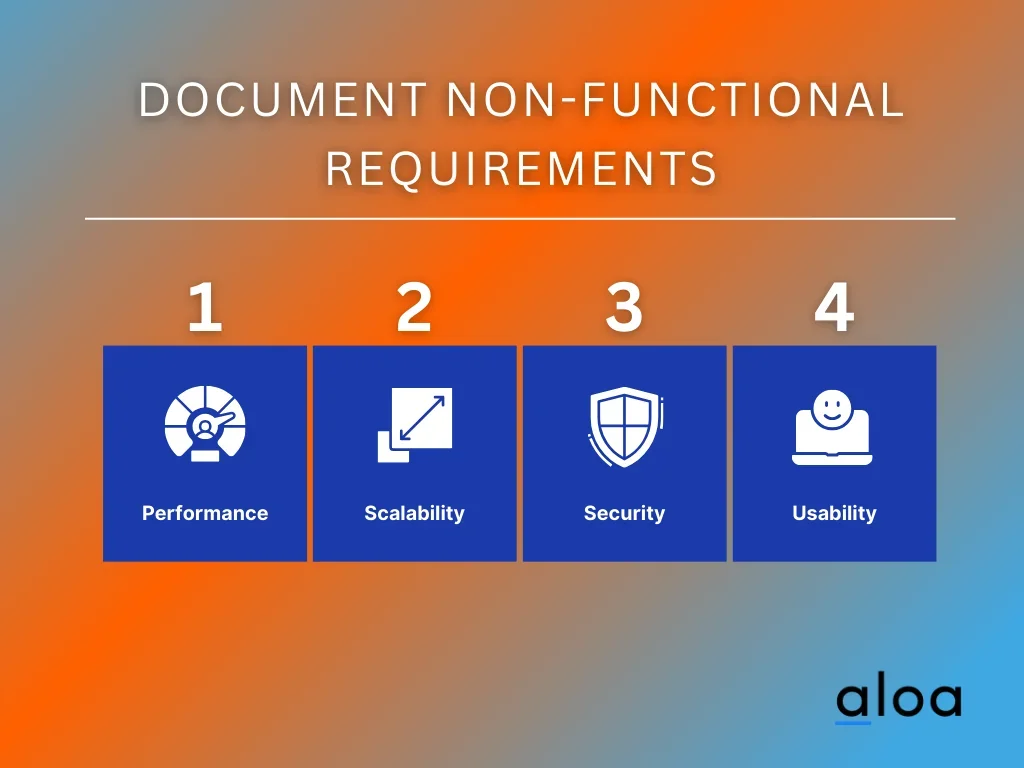
- Performance: Specify metrics for response time, throughput, and resource utilization.
- Scalability: Define how the system should handle increasing loads and data volume.
- Security: Outline authentication, authorization, data encryption, and audit trails.
- Usability: Detail user interface guidelines, accessibility features, and user experience expectations.
Including these non-functional requirements ensures that the software meets functional expectations and delivers the desired performance, security, and usability. This comprehensive approach to requirement documentation in software engineering sets the stage for successful project execution and client satisfaction.
Step 4: Review and Validate Requirements
Active engagement with stakeholders is paramount in ensuring that the requirement documentation in software engineering effectively reflects their needs and expectations. Stakeholder reviews provide valuable insights into the accuracy and relevance of the documented requirements, allowing for adjustments to be made in real time. Validation processes rigorously assess the feasibility, consistency, completeness, and clarity of the requirements, guaranteeing their alignment with project objectives.
Any discrepancies or ambiguities can be promptly addressed through iterative feedback loops, leading to a refined and robust documentation framework. Prioritizing thorough reviews and validations, software development teams uphold the integrity and relevance of their requirement documentation, laying a solid foundation for successful project execution and client satisfaction.
Step 5: Document Assumptions and Constraints
In requirement documentation for software engineering, it's crucial to document assumptions and constraints to ensure clarity and alignment throughout the project. Here's how to approach this step effectively:
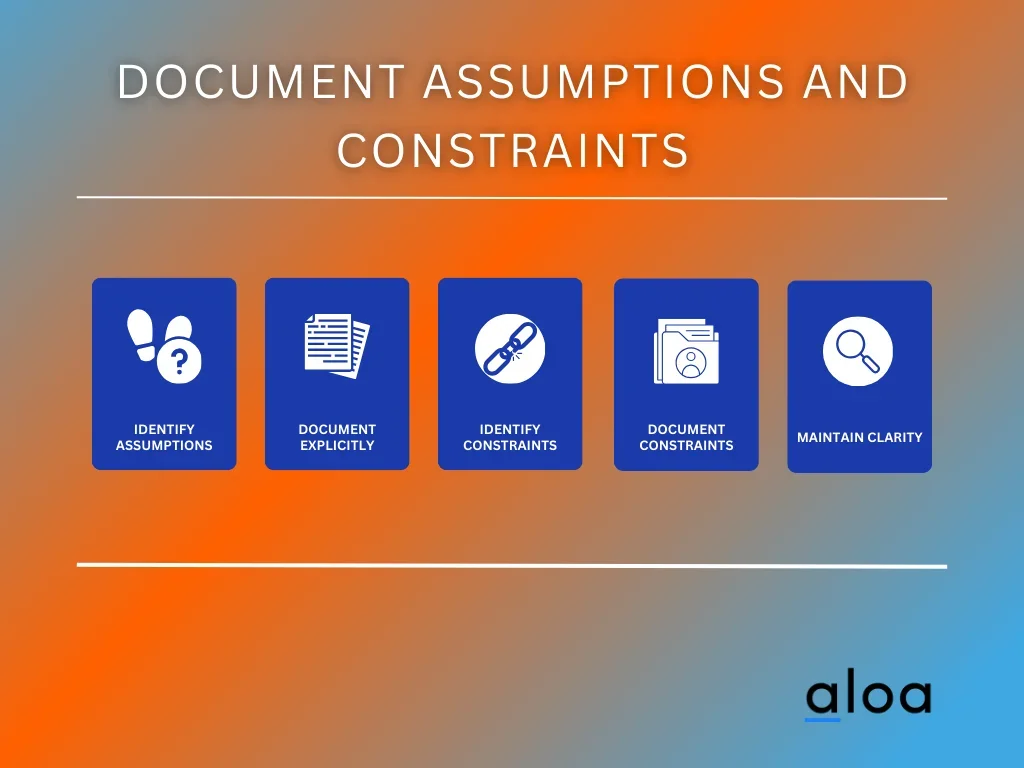
- Identify Assumptions: Actively identify any assumptions made during requirement elicitation. These could involve expectations about user behavior, system interactions, or technological capabilities.
- Document Explicitly: Document all assumptions to prevent misunderstandings and align stakeholder expectations. Using an online AI paraphraser can help you achieve concise language while preserving meaning and overall context.
- Identify Constraints: Identify any constraints that could affect the development process. These constraints may include budget limitations, technological restrictions, or regulatory requirements.
- Document Constraints: Document all constraints to guide the development team and ensure compliance throughout the project lifecycle.
- Maintain Clarity: Regularly review and update the documentation to reflect any changes in assumptions or constraints.
In documenting assumptions and constraints, teams can mitigate risks and ensure all stakeholders know the project's boundaries and limitations. This transparency fosters better communication and decision-making throughout the software engineering process, ultimately leading to more successful project outcomes.
Step 6: Maintain and Manage Requirements
In requirement documentation in software engineering, maintaining and managing requirements is critical to ensure project success. Establishing a robust process ensures clarity and consistency from inception to deployment. It begins with implementing version control mechanisms to track changes and updates in the documentation meticulously. Teams can easily trace the evolution of requirements and address any discrepancies effectively.
Any alterations to requirements must undergo thorough documentation, review, and approval by pertinent stakeholders. This ensures that all modifications align with project objectives and stakeholder expectations. Effective communication of these changes across the team is imperative to uphold alignment and understanding among all members involved in the project. Maintaining and managing requirements is pivotal in navigating the complex landscape of software engineering projects.
Who Uses the Requirements Document and Why?
Requirement documentation in software engineering guides various stakeholders throughout the software development lifecycle. Let's delve into who utilizes this documentation and why it's indispensable for each role.
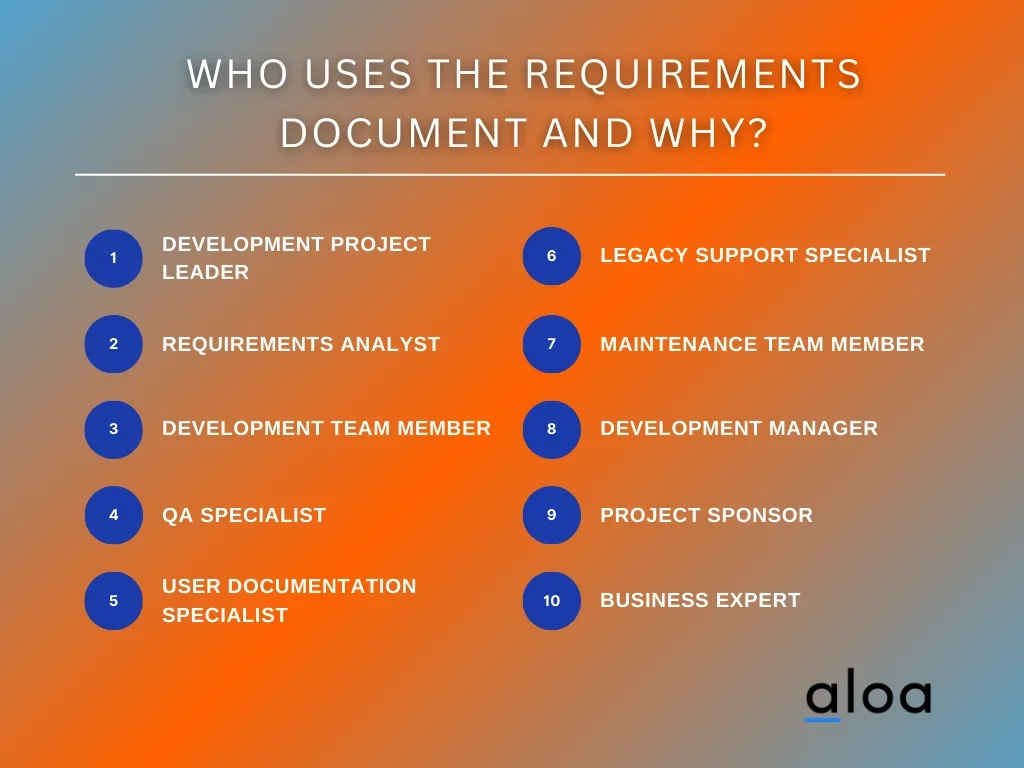
- Development Project Leader: Utilizes the requirement documentation to establish project direction, allocate resources effectively, and ensure alignment with organizational objectives. This ensures smooth project execution and timely delivery.
- Requirements Analyst: Analyzes and interprets the documented requirements to identify potential gaps, inconsistencies, or conflicts. This critical role ensures the requirements are comprehensive, clear, and feasible.
- Development Team Member: Relies on the requirement documentation to understand the scope of work, prioritize tasks, and develop software solutions that meet specified requirements. This promotes collaboration and streamlines the development process.
- QA Specialist: Uses the documented requirements to design test cases, verify software functionality, and ensure the final product meets quality standards. This helps in detecting and resolving defects early in the development cycle.
- User Documentation Specialist: Leverages the requirement documentation to create user manuals, tutorials, and other documentation that assists end-users in understanding and utilizing the software effectively. This enhances user experience and reduces support inquiries.
- Legacy Support Specialist: References the requirement documentation to understand the original design and functionality of the software, aiding in troubleshooting and maintaining legacy systems.
- Maintenance Team Member: Relies on the documented requirements to implement changes, updates, and enhancements to the software over its lifecycle. This ensures the software remains relevant and effective in meeting evolving user needs.
- Development Manager: Oversees the entire development process, ensuring that the documented requirements are met within budget and schedule constraints. This role is crucial in driving project success and achieving organizational objectives.
- Project Sponsor: Reviews the requirement documentation to ensure the project aligns with business goals, regulatory requirements, and stakeholder expectations. This helps in securing funding and support for the project.
- Business Expert: Provides domain-specific knowledge and insights during the requirement elicitation process, ensuring the documented requirements accurately reflect business needs and priorities. This alignment between technical and business requirements is essential for delivering value to the organization.
Best Practices for Creating and Maintaining Requirement Documentation
Creating and maintaining requirement documentation in software engineering is critical to project success. Here are five best practices to ensure the effectiveness and accuracy of your documentation:
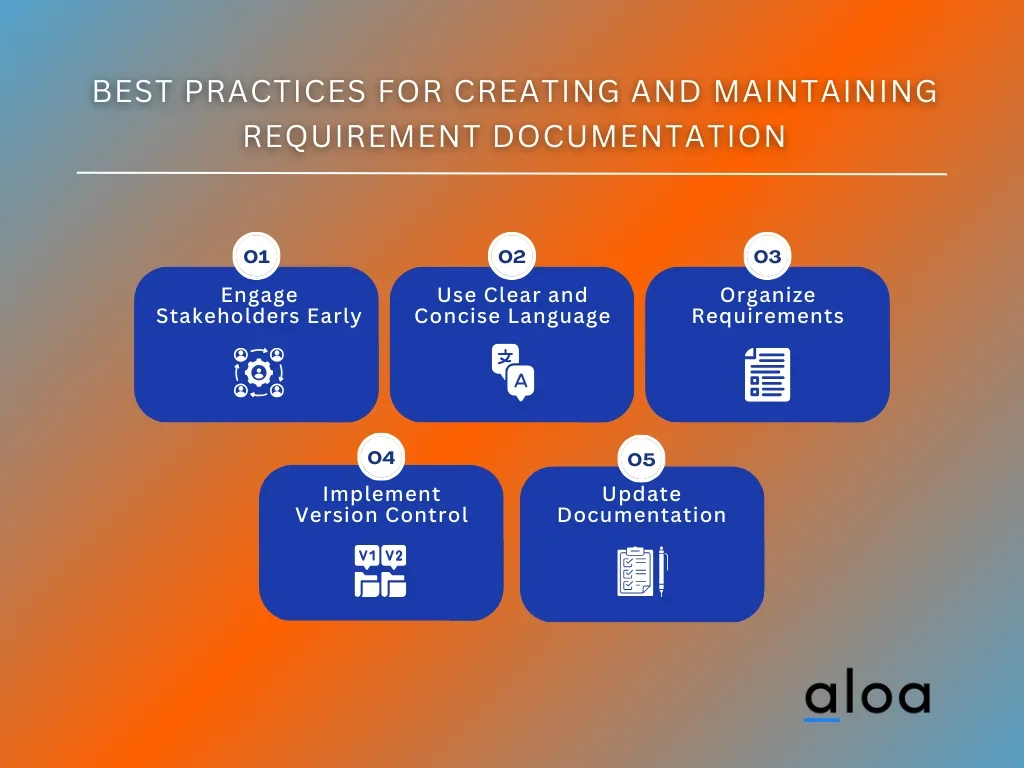
Involve Stakeholders from the Beginning
When creating requirement documentation in software engineering, it's crucial to involve stakeholders from various departments and levels of the organization. This ensures that all perspectives are considered and requirements accurately reflect the needs of end-users and other stakeholders. Involving stakeholders early can gather valuable insights and avoid misunderstandings later.
Use Clear and Concise Language
Effective requirement documentation relies on clear and concise language to communicate requirements accurately. Avoid ambiguous terms or technical jargon that non-technical stakeholders may need to understand. Use simple language that is easy to understand, and provide examples or illustrations where necessary to clarify complex concepts. Clear communication ensures that all stakeholders are on the same page regarding project requirements.
Organize Requirements Methodically
Organizing requirement documentation methodically helps maintain clarity and accessibility. Use a structured approach, such as categorizing requirements based on their priority, functionality, or system component. This makes it easier for stakeholders to locate specific requirements and understand their significance within the project. Maintaining a consistent format throughout the documentation also streamlines the review and validation process.
Implement Version Control
Version control is essential for managing changes and revisions to requirement documentation. Implement a robust version control system that tracks modifications, identifies contributors, and maintains a history of changes. This allows stakeholders to review previous versions of the documentation and understand how requirements have evolved. Version control also helps prevent conflicts and inconsistencies between different versions of the documentation.
Regularly Review and Update Documentation
Requirement documentation in software engineering is not static and should be reviewed and updated throughout the software development lifecycle. Schedule periodic reviews with stakeholders to validate requirements, address any changes or new insights, and ensure alignment with project goals. Update the documentation accordingly to reflect any modifications or additions to requirements. Regular reviews and updates help maintain the relevance and accuracy of requirement documentation over time.
Benefits of Creating Software Requirements Document
Creating a software requirements document in software engineering offers many benefits, crucial for the success of any development endeavor. Let's delve into five key advantages:
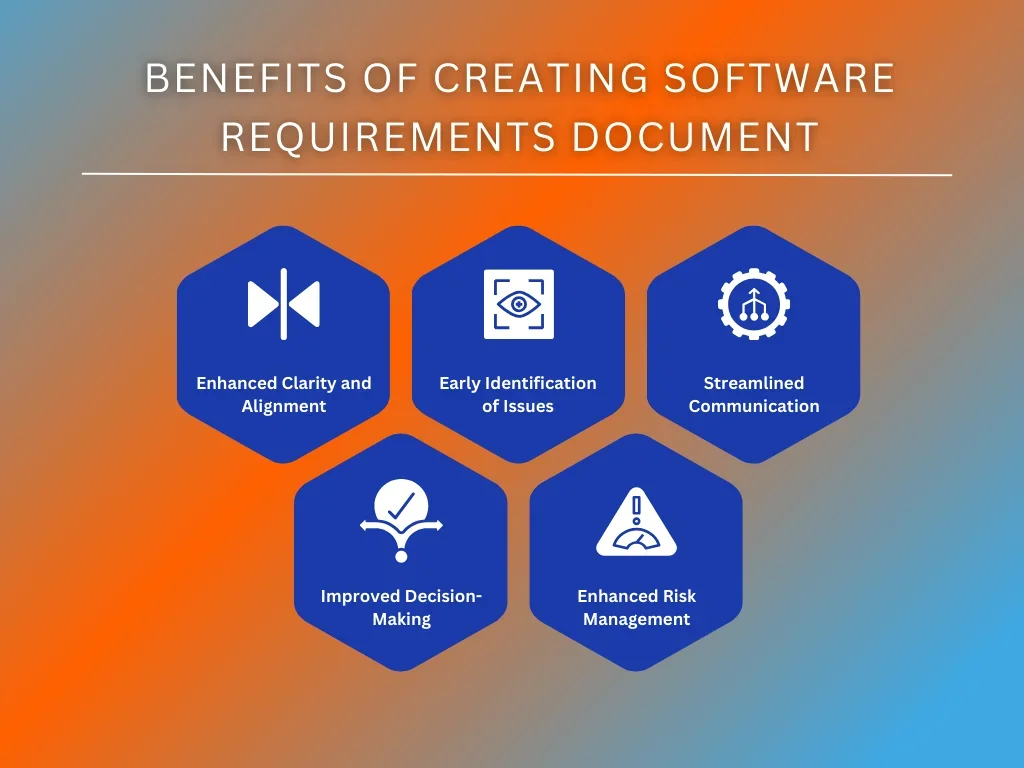
Enhanced Clarity and Alignment
One of the primary benefits of requirement documentation in software engineering is the clarity it provides to all stakeholders involved. Precisely outlining the functional and non-functional requirements, teams ensure everyone is on the same page regarding project objectives and expectations. This clarity helps align efforts towards a common goal, reducing the likelihood of misunderstandings and discrepancies during development.
Early Identification of Issues
Meticulously documenting requirements, teams can identify potential issues and challenges early in the development lifecycle. Disc discrepancies or conflicts between stakeholder expectations and technical feasibility can be detected and addressed proactively through thorough analysis and validation. This proactive approach minimizes the risk of costly rework or delays later in the project timeline.
Streamlined Communication
Clear and concise requirement documentation is a central communication hub for all project stakeholders. It provides a structured framework for discussing project scope, objectives, and deliverables, facilitating effective communication among developers, project managers, clients, and other relevant parties. This streamlined communication ensures that everyone remains informed and engaged throughout the development process, fostering collaboration and teamwork.
Improved Decision-Making
A comprehensive software requirements document empowers teams to make informed decisions throughout the development lifecycle. Referencing the documented requirements, teams can evaluate proposed solutions, assess their alignment with project goals, and make decisions based on objective criteria. This data-driven approach minimizes the risk of subjective decision-making and ensures that project decisions are grounded in the project's objectives and constraints.
Enhanced Risk Management
Effective requirement documentation is crucial in risk management by identifying and mitigating potential risks early in the project lifecycle. Clearly defining project scope, objectives, and constraints, teams can anticipate and address potential challenges, such as technical constraints, resource limitations, or external dependencies, before they escalate into significant issues. This proactive risk management approach helps ensure project success by minimizing the likelihood of costly delays or failures.
Key Takeaway
Meticulously documenting software documentation specifications, teams can streamline the development process, minimize misunderstandings, and deliver high-quality software products. This practice enables stakeholders to understand project objectives, functionalities, and constraints clearly, reducing the risk of miscommunication and project scope creep.
Requirement documentation in software engineering facilitates efficient project management by providing a roadmap for development teams. With clearly defined requirements, project managers can allocate resources effectively, establish realistic timelines, and monitor progress more accurately. Comprehensive documentation helps identify potential risks and challenges early in the development lifecycle, allowing teams to address them proactively before they escalate into significant issues.
Organizations can significantly enhance their software development processes by prioritizing requirement documentation in software engineering, resulting in improved client satisfaction, reduced rework, and increased project success rates. Sign up for our email list at Aloa blog to stay updated on the latest insights and best practices in software engineering.

